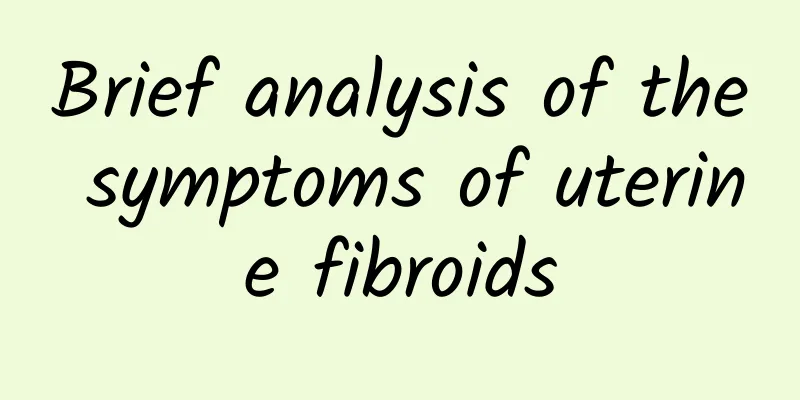Brief analysis of the symptoms of uterine fibroids

|
Many female friends may know about uterine fibroids, but they are not very clear about the symptoms of uterine fibroids. What are the symptoms of uterine fibroids ? Let's talk about the symptoms of uterine fibroids. Generally, symptoms of uterine fibroids include: 1. Menstrual changes and increased leucorrhea Menstrual changes are the most common symptoms of uterine fibroids, which include shortened menstrual cycles, increased menstrual flow, prolonged menstrual periods, irregular vaginal bleeding, etc. Leucorrhea increases, sometimes with a large amount of purulent and bloody discharge and slough-like tissue discharge with a foul odor. 2. Compression symptoms When the fibroids grow forward or backward, they can compress the bladder, urethra or rectum, causing frequent urination, dysuria, urinary retention or constipation. When the fibroids grow to both sides, they form broad ligament fibroids, which compress the ureter and cause hydroureter or renal pelvis. If they compress the pelvic blood vessels and lymphatic vessels, they can cause lower limb edema. These are also symptoms of uterine fibroids. 3. Infertility and anemia Symptoms of uterine fibroids also include compression of the fallopian tubes by the fibroids causing them to twist, or deformation of the uterine cavity which prevents the fertilized egg from implanting, leading to infertility. If the patient has excessive menstruation for a long time, it may lead to secondary anemia, and symptoms such as general fatigue, pale complexion, shortness of breath, and palpitations. 4. Abdominal distension and pain Patients with uterine fibroids often have a distended abdomen, a mass felt in the lower abdomen, and a feeling of falling. Generally, patients do not have abdominal pain, but often have lower abdominal distension, back pain, etc. When the subserosal fibroid pedicle is twisted, acute abdominal pain may occur. When the fibroid turns red, the abdominal pain is severe and accompanied by fever. This is also a symptom of uterine fibroids. The above is an introduction to the symptoms of uterine fibroids. Here we remind everyone that once symptoms of uterine fibroids appear, you must go to the hospital for treatment in time to avoid worsening of the condition. For more information, please visit the uterine fibroid disease special topic at http://www..com.cn/fuke/zgjl/ or consult an expert for free. The expert will then give a detailed answer based on the patient's specific situation. |
<<: What are the treatments for uterine fibroids?
>>: Three types of women are prone to uterine fibroids
Recommend
What are the dangers of irregular menstruation in women?
What are the dangers of irregular menstruation in...
Don’t eat sugary foods for dinner and stay away from fat! Pay attention to side dishes and dipping sauces
It is common for office workers to go to nearby r...
What should I do when I have uterine fibroids and my menstruation comes? 4 nursing measures are critical
When a patient with uterine fibroids has menstrua...
What is the ranking of menopausal hospitals?
For many female friends, it is not difficult to t...
Does eating spicy food help you lose weight? Eating too much spicy hotpot can cause your blood pressure to get out of control? Doctors reveal: "Eating spicy food" and "eating spicy hot pot" are two different things
This Thursday (7th) is the beginning of winter am...
What are the methods for testing for bacterial vaginosis?
With the development of society, people's wor...
What are the dangers of amenorrhea
What are the dangers of amenorrhea? Amenorrhea ha...
What are the preventive measures for irregular menstruation?
Irregular menstruation is one of the common probl...
What are the symptoms of severe complications of uterine fibroids?
Uterine fibroids are a benign tumor, but the inci...
The main reason for cervicitis is low body resistance
The appearance of cervicitis is too common in tod...
How much does it cost to treat congenital absence of vagina?
How much does it cost to treat congenital absence...
Traditional Chinese medicine can treat abnormal leucorrhea
Abnormal vaginal discharge can be improved throug...
What causes irregular menstruation?
What causes irregular menstruation? 1. Abnormal e...
What tests should be done before abortion?
For women who want to have an artificial abortion...
How to regulate irregular menstruation for women? What are the causes of irregular menstruation for women?
There are many reasons for irregular menstruation...









